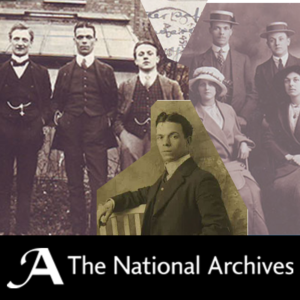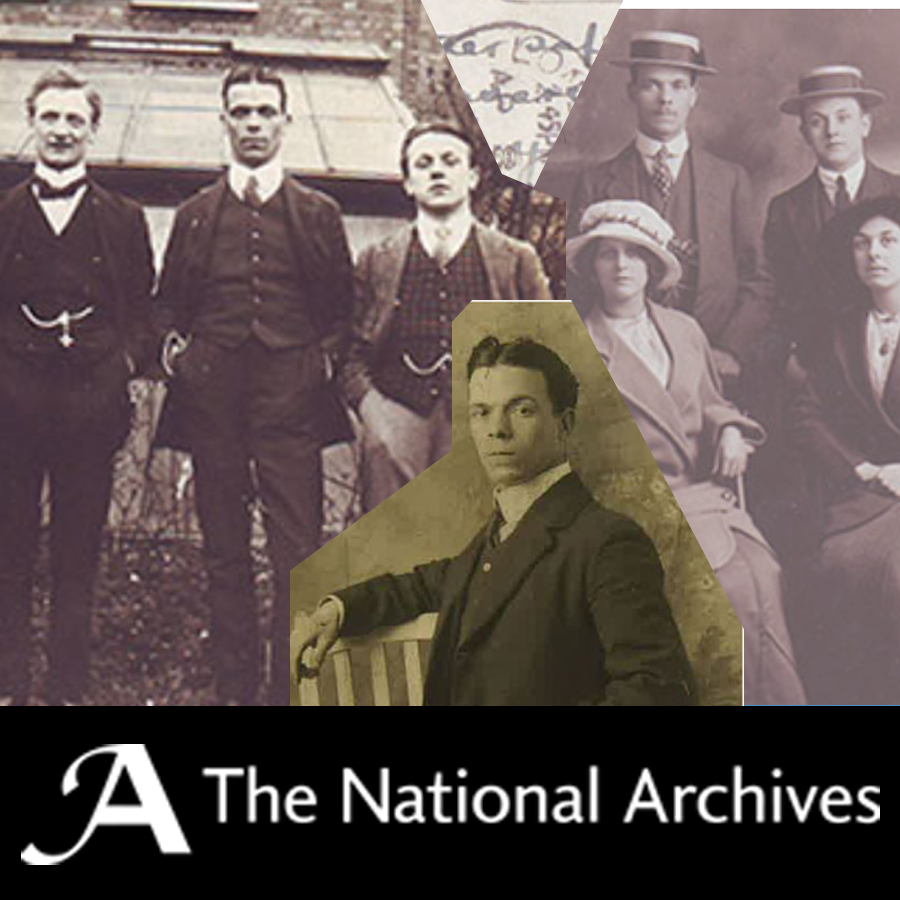 Caroline James, blog author at The National Archives UK, has shared this blog as part of our ongoing “How I Solved It Series”. This blog is the second part of the story about one man that served in WWI. This blog was originally posted in 2014. Caroline shares with us how she discovered who he was and where he served. Now she has more information plus his burial site. View Part One.
Caroline James, blog author at The National Archives UK, has shared this blog as part of our ongoing “How I Solved It Series”. This blog is the second part of the story about one man that served in WWI. This blog was originally posted in 2014. Caroline shares with us how she discovered who he was and where he served. Now she has more information plus his burial site. View Part One.
It has been almost two years since we launched our My Tommy’s War blog series with My Tommy’s War: An Eastender in the Lancers, a blog about my great-great uncle Charles Hunt. I had no idea then of the personal journey I was about to embark on and how much I would discover about a man who had died in the opening days of the First World War.
The premise of My Tommy’s War is simple; to follow staff of The National Archives as they research their First World War ancestors during the centenary period, sharing hints and tips along the way. Like most people I began with sparse information about Charles, gleaned mainly from two medal cards and a handful of photographs. I shared the same frustrations as many of you at having no surviving service record as it was destroyed in the Second World War, leaving me to piece together Charles’s history from disparate and scattered information. As a result, my first blog was mainly a list of questions and ‘what if’s’ based on the history of his regiment – 12th (Prince of Wales’s) Lancers and the knowledge that Charles was from the East End of London.
What I have found out in the intervening 18 months has astounded me. In this follow-up blog I’ve tried to capture as much as I can of my journey to discover Charles, highlighting records and resources that might be most useful to anyone undertaking their own research. I’ve also given advice based on my experience of how to go beyond archives to find and piece together the history of a ‘Tommy’.
I cannot stress how important it is to explore all archives, records and resources in researching your ancestor and to share their story as widely as you can. There are many ways to do this, including IWM’s Lives of the First World War, The Royal British Legion’s Every Man Remembered and requesting that your ancestor’s name be read out in the Roll of Honour, part of The Tower of London Remembers series. I did this for Charles and his name was read out on 7 August 2014. You could also approach the regimental museum of your ancestor or get involved with your local Family History society to see what records they have and what activity they are planning to mark the First World War centenary.
As you read on, you’ll see that I’ve learned so much about Charles that I keep thinking it’s impossible to find out anything else. But each time I think that, something new comes along to surprise me. I can’t wait to find the next piece of the puzzle of the life of my great, great uncle Charles, a man who was so determined to join the army that he enlisted twice; a man who died trying to save his comrades; a man with childhood friends who kept his memory alive to their children; a man who was missed and mourned by his pals from his regiment and by his family back home. Importantly for me, Charles is the man whose story has put a human face to the First World War. For that I will be forever thankful to him.
I hope you find what follows useful and that it helps you find your own Tommy. Don’t leave them to languish in the anonymity of records. Find them, claim them and remember them.
They deserve it.
The fateful day for Charles – 25 August 1914
One of the main questions in my first blog was what date did Charles die? Thanks to the help of people who contacted me, I now know that Charles was mortally wounded in an action on 25 August 1914 while trying to extract men of his troop from a German attack. Regimental experts and descendants of other 12th Lancers pointed me to two records in the collection of The National Archives that record this action; WO 95/1140/1 the unit war diary of the 12th Lancers and WO 161/95/25, a statement from our Prisoner of war interview records 1914-1918 made by Lieutenant RS Moore, who led the 12th Lancers in this action and was wounded and taken prisoner.
Extract from record series WO 161/95/25, a statement from Prisoner of war interview records 1914-1918 made by Lieutenant RS Moore, 12th Lancers
His statement includes an amazing level of detail of a fight in the woods where a troop of Lancers found themselves overwhelmed by a battalion of Germans. Lieutenant Moore makes reference to two men of his regiment who died overnight on 26 and 27 August 1914 from their wounds after being taken to the Red Cross Hospital in Bavay (Bavai). Although Charles is recorded as dying on 29 August, it is generally accepted that he died earlier and, as he is buried beside his comrade WW Totman in Bavay, it’s also possible that he is one of the men referred to by Lieutenant Moore. If so, then he is likely to be the man who died of a ‘severe bullet wound to the stomach’.
Without advice from experts, it would never have occurred to me to look in prisoner of war statements. But this is proof that it is not only obvious records that yield crucial information. Knowing that a member of my family died in such an awful manner makes for hard reading but I believe it’s important to have all of the facts to appreciate what they went through.
Regimental experts also kindly provided me with excerpts from personal diaries that mentioned Charles. It’s clear from these diaries that he had very close friends amongst his comrades. His nickname was Mick Hunt (why, I’m unsure) and I know that in the lead up to embarkation for France, he ‘mucked in’ with three of his pals who looked after each other in the grub line as well as all getting their hair cut with horse clippers! And before embarkation he went for a bite to eat at a coffee shop with a pal. The most touching entry from these diaries was made when Charles died. One of his pals recorded that ‘Poor Mick Hunt was shot and died from his wounds’.
With all of this information confirming Charles’s death, I was able to locate his grave in Bavay using the website of the Commonwealth War Graves Commission (CWGC). CWGC have recently added scanned images of original documents to the record of each man, including any inscriptions that family asked to be added and, in some cases, detail of how and where the man’s body was found. They provide a fascinating insight into the burial process and for me they also revealed that for a time it was thought that Charles was buried in a different graveyard.
Charles’s military career
I received some great advice that a man’s service number indicates when he joined his regiment. Charles’s number – 127 – showed that he enlisted in around 1907 which meant he would have served with his regiment in the UK as well as in India and South Africa. I received another clue to his South African experience – more of that later…
Excitingly for me, I was able to confirm that Charles’s military experience actually began before 1907. Although I was disappointed that I could not find a service record, I kept being drawn to a military pension record for another Charles Hunt on Findmypast, who was born in Mile End but in 1886 not 1888. I discounted it on a number of occasions but it niggled at me and I finally gave in and downloaded it. I was glad I did. It was my Charles after all! In 1904 and at barely 16 years of age, Charles had lied about his age to join the Border Regiment in Carlisle. He somehow managed to keep up the pretence until he was discharged 9 months later for lying about his age. In my previous blog, I stressed the need to have known facts to check against. When I saw that he was sent home to his father at 36 Squirries Street, Bethnal Green, I knew it was my man. The pension record revealed lots of wonderful information including a physical description of a slight, brown eyed, brown haired youth of 5ft 5 3/4.
I find it fascinating that a 16 year old boy managed to fool the regiment for so long. I have no idea whether on joining the 12th Lancers three years later he ‘accidentally’ forgot to tell the recruiters about his previous discharge. Perhaps record keeping in those days was such that his pension record didn’t follow him…
A group photograph of Charles’s regiment – the 12th (Prince of Wales’s) Lancers – in my first blog proved so popular that we made a large version available on The National Archive’s Flickr channel.
Charles’s best friends!
Charles Hunt with his friends the Stradling brothers (used with permission from a private collection)
After a version of my original blog was published in ‘The Cockney Ancestor’ the newsletter of the East of London Family History Society, I was contacted by a lady from Australia. She told me that she thought Charles had been good friends with her grandfather and his brother. I hardly dared believe that it was true but a few emails later I had photos of Charles with his friends George Stradling (b.1887) and Charles Stradling (b.1889). The Stradlings lived a few roads away from the Hunts in Bethnal Green and the closeness of their relationship is clear in the photos. I also received a scan of a postcard that Charles sent to George from South Africa wishing him a happy birthday and telling him to ‘Be Good!’
George and Charles Stradling both served in the First World War and unfortunately, Charles Stradling died in France in 1916 at the Somme. He is commemorated on the same war memorial as my Charles, in St Matthew’s Church, Bethnal Green.
It is lovely to have this photographic record of the three lads together, all so proud and all, thankfully, oblivious to what lay ahead. I’m also intrigued by the pretty girl in the photo with both Charles. If anyone knows who she is, I would love to know – please do get in touch.
What other information is out there about a person?
If you’re looking for your own First World War ancestor then our portal is a great place to begin your research. You shouldn’t however limit yourself to military records. There is a wealth of other information available online to search. Much of this is available through organisations such as Ancestry and Findmypast. Aside from the military pension record already mentioned, I have been able to find many other records relating to Charles, including census records, a record of his baptism and even his school enrolment. This all adds to the picture that you build of your ancestor. I still have the local East End archives and newspaper archives to explore and can’t wait to see what they reveal.
My pilgrimage
Charles Hunt’s Grave in Bavay Communal Cemetery, France (used with permission from a private collection)
Inevitably Charles’s story would only end one way. I kept the promise made in my first blog and on Friday 29th August 2014, one hundred years to the day after it’s recorded that Charles died of his wounds, I stood at his grave in the French village of Bavay. Charles is one of twelve First World War servicemen buried in this small and very peaceful rural cemetery. Three died in 1914 and nine in 1918 – a reminder that that part of France was behind German lines for the majority of the war.
I was nervous and excited in equal measures to visit the final resting place of Charles. I was delighted to see that a bouquet of flowers had been placed on each First World War grave – presumably by the locals at the beginning of the centenary period – and was glad to lay my wreath of poppies to honour the man I have come to know as much more than a soldier in a black and white photo. I left a brief history of him and some photos so that anyone passing that grave would know who is buried there.
With the intense activity surrounding the First World War, it would be easy to become immune to it but on that morning in a graveyard in France, I connected on a very human and very personal level with the meaning and sacrifice of the conflict. I experienced just an inkling of the emotional impact that Charles’s death would have had on my family on the day one hundred years earlier that they lost their eldest son and big brother. To be at Charles’s grave on the centenary of the day he gave his life was a very proud moment for me.
If you have a story idea or a blog that you’d like to share as part of this series, please let us know about it in the comments.






